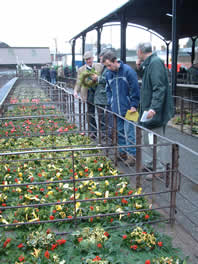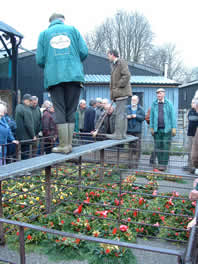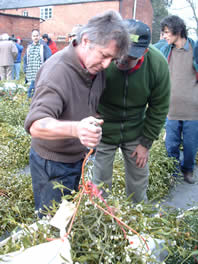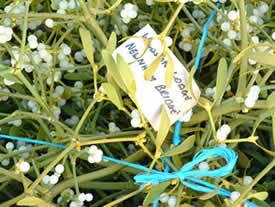
Tenbury Mistletoe and Holly Auction
Text: Rowan
Photographs: Rowan
One of the best kept secrets of Britain's traditional calendar is the Mistletoe and Holly Auctions which take place at Tenbury Wells in north-west Worcestershire on the last Tuesday in November and the first two Tuesdays in December. The auction, conducted by local agricultural auctioneers Brightwells at their Tenbury cattle market and auction yard, has taken place annually on the same site for some 150 years – until 2004, when the last auction was conducted on the old site before Brightwells surrendered their lease on the property. In 2005 the auction was held as usual though on a different site in the vicinity.
So who attends the auctions and what goes on there?
There are in effect two main products on sale – firstly, cut holly and mistletoe and secondly, made-up wreaths and other seasonal floral arrangements. The cut holly and mistletoe is brought in by a mixture of the farmers and other landowners who have harvested it from their own property and by gypsies and travellers who seem to acquire it somehow or other, while the wreaths are mostly the work of farmers' wives, gypsies and local craft-workers out to make a few bob for Christmas.
The buyers are generally market traders and the owners of small garden centres and shops who are buying wholesale to sell on to retail customers and they come from as far afield as the Thames Valley, Yorkshire and the East Midlands with lorries and vans of all sizes from Transit upwards, so if you've ever bought a wreath or a bunch of mistletoe from a greengrocer or market stall you may well have bought greenery which came from the Tenbury auction.
The day begins early with the sellers setting out their wares. The wreaths are laid out in lots, each lot in one of the livestock auction pens in the Dutch barn, from 6 to 15 identical items in each pen depending on their size and elaborateness of the wreaths in the lot. Looking at the designs of the wreaths and the materials used, one quickly begins to get a feel for certain lots being by the same maker. One lot, for example, may use plain green holly and blue ribbons and another variegated holly and red ribbons but both may use the same silver fir-cones and the underlying design will be virtually identical.
The cut holly and mistletoe, laid out on sacks which are bound corner to corner to create a secure package and clearly labelled with the seller's name, are laid out in rows across the auction yard with narrow aisles between them.
The buyers arrive, register at the office and are given a registration number against which any successful bids are registered for eventual settlement. Then they begin to examine the goods on offer. How well-made are the wreaths? Are there plenty of berries on the holly? Is there plenty of variety in the holly on offer? Is the mistletoe fresh and recently cut? Does it have plenty of berries? When it comes to berries there is no perfect year: if the holly has plenty there are few on the mistletoe and vice versa. It's all to do with the weather in the preceding summer and autumn, and this strongly affects the relative prices of the cut plants at the market. Some of the buyers produce the sort of scales used by anglers for weighing fish, keen to get a sense of the weight of a particular bundle and decide what they're willing to pay for it. A bound bundle of mistletoe with plenty of berries may go for as much as £30, but by the time it's broken into bunches or sprigs to be sold at £2 or so each it may have a retail value of £100 or more.
If time allows, a cup of tea and a bacon butty from the Temeside Café is in order. Built of corrugated iron and covered with the peeling remains of an ancient coat of green paint, this cabin is of indeterminate age but probably dates from the 1920s or 1930s. Shabby and homely, run by elderly local women sporting pinnies and its windows always steamed up when in use, it seems like a set from an episode of Heartbeat or even All Creatures Great and Small .
At 10am sharp the auctioneer (seen in the photographs in a brown coat and dark glasses and variously leaning on his thumbstick or using it as a pointer) rings the bell to signal the start of the auction and leads the way to the barn. As the crowd and the auctioneer move from one pen to the next, each lot is bid for in turn with the price ranging from £2 per wreath for the simplest pieces up to £6 or even more for the largest and most elaborate ones. The price bid is per item, so the winning bid must be multiplied by the number of pieces in the lot. It would be very easy indeed for an unwary visitor to assume that £5 bought a dozen weaths and find themselves duly embarrassed. As the sale proceeds the sold lots are quickly cleared by their buyers who take the wreaths away cunningly threaded onto broom handles. By 11am the wreaths have usually all been sold.
If there are Christmas trees in the sale, they are auctioned next before the gaggle of auctioneer and buyers move on to the main part of the sale – the cut holly and mistletoe laid out in the yard. Starting at the top corner nearest the company's offices, the group progressively moves down the first row and up the second. Bundles may be batched in twos or threes for bidding if they belong to the same seller or treated individually if not, or a single bundle may be bid for with the successful bidder being given an option over the however many identical bundles following. In other words they are given the opportunity buy any or all of them at the same price and if the option is not taken the bundles are auctioned as normal. Gradually the group moves out across the yard, weaving up and down alternate rows.
One both occasions that I've attended the sale as a visitor there has been an old boy of the Joe Grundy variety who, presumably a seller, follows the group and sings the praises of certain bundles as the buyers turn their attention to them. "Look at the berries on that!" and "You won't see better mistletoe than that this year!" goes the endless refrain. The crowd clearly find him amusing without taking any notice of his exhortations. He's clearly a regular "character" at the sales and known to all.
Noticeably, the price of the bundles drops off as the sale progresses, the first bundles generally selling for up to twice the price of those at the end of the sale. Indeed, in years when there's a glut or when either the holly or mistletoe is perceived to be poor quality, for example having few berries, the last bundles may not sell at all. At the last of the three sales in December 2004, I overheard several comments about the previous week's sale having been little better than a flop with mention of a number of sellers who hadn't bothered to attend the final sale because of low prices or unsold stock. Clearly it pays to arrive very early and position your bundles of holly and mistletoe at the beginning of the sale in order to ensure sales and good prices.
By 1pm or a little later the sale is over and all that remains is for the last of the bought stock to be gathered up and loaded into the lorries and vans belonging to the buyers.
As I said at the beginning of this essay, these auctions are virtually unknown to the wider public. This is probably because they take place on a working day in the run-up to Christmas, at a time when if members of the public are inclined to take a day off work they're much more likely to go shopping than drive out to a small market town in the back of beyond. It's not as though one could bid for and bring back a single wreath for the front door, after all. Nevertheless the auctions are gradually becoming better known, having been featured a couple of years ago on the BBC's Countryfile programme when John Craven and a camera crew arrived to film the event and talk to the sale's regular attenders. The unfortunate Mr Craven managed to excite a passing old dear with his sprig of mistletoe and was grabbed and snogged with some determination for his pains.
..












